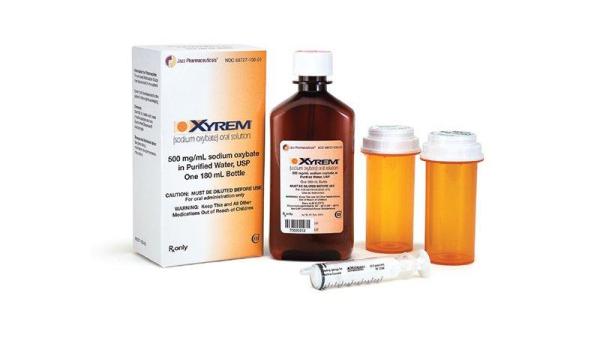Sodium oxybate Disease Interactions
There are 6 disease interactions with sodium oxybate.
- Depression
- Hx drug/alcohol abuse
- Glaucoma
- Liver disease
- Sensitivity to salt intake
- Sleep apnea/respiratory depression
Anxiolytics/sedatives/hypnotics (applies to sodium oxybate) depression
Major Potential Hazard, Moderate plausibility.
A variety of abnormal thinking and behavior changes have been reported to occur in association with the use of most anxiolytics, sedatives and hypnotics. Some of these changes include decreased inhibition, aggressiveness, agitation, and hallucinations. These drugs can cause or exacerbate mental depression and cause suicidal behavior and ideation. Therapy with these drugs should be administered cautiously in patients with a history of depression or other psychiatric disorders. Patients should be monitored for any changes in mood or behavior. It may be prudent to refrain from dispensing large quantities of medication to these patients.
References
- (2002) "Product Information. Buspar (buspirone)." Bristol-Myers Squibb
- (2001) "Product Information. Ambien (zolpidem)." sanofi-aventis
- (2001) "Product Information. Placidyl (ethchlorvynol)." Abbott Pharmaceutical
- (2001) "Product Information. Aquachloral Supprettes (chloral hydrate)." Medisca Inc
- (2001) "Product Information. Equanil (meprobamate)." Wallace Laboratories
- (2001) "Product Information. Sonata (zaleplon)." Wyeth-Ayerst Laboratories
- (2001) "Product Information. Precedex (dexmedetomidine)." Abbott Pharmaceutical
- (2002) "Product Information. Xyrem (sodium oxybate)." Orphan Medical
- (2004) "Product Information. Lunesta (eszopiclone)." Sepracor Inc
- (2005) "Product Information. Rozerem (ramelteon)." Takeda Pharmaceuticals America
- (2010) "Product Information. Silenor (doxepin)." Somaxon Pharmaceuticals
- (2013) "Product Information. Unisom (doxylamine)." Pfizer U.S. Pharmaceuticals Group
- (2014) "Product Information. Hetlioz (tasimelteon)." Vanda Pharmaceuticals Inc
- (2014) "Product Information. Belsomra (suvorexant)." Merck & Co., Inc
Sodium oxybate (applies to sodium oxybate) hx drug/alcohol abuse
Major Potential Hazard, Moderate plausibility. Applicable conditions: Drug Abuse/Dependence, Alcoholism
Sodium oxybate should not be used with alcohol. This drug should be used with caution in patients with history of drug or alcohol abuse. The inappropriate use of this drug alone or in combination with other CNS depressants is associated with CNS adverse reaction including seizures, respiratory depression, decreases in the levels of consciousness, coma and death. Because illicit use and abuse has been reported, physicians should evaluate carefully their patients for history of drug or alcohol abuse and should follow such patients closely, observing them for signs of misuse.
References
- (2002) "Product Information. Xyrem (sodium oxybate)." Orphan Medical
Anxiolytics/sedatives/hypnotics (applies to sodium oxybate) glaucoma
Moderate Potential Hazard, Moderate plausibility. Applicable conditions: Glaucoma/Intraocular Hypertension, Urinary Retention
Some hypnotic drugs can have an anticholinergic effect and should be used with caution in patients with glaucoma, and trouble urinating due to retention or enlarged prostate.
References
- (2002) "Product Information. Benadryl (diphenhydramine)." Parke-Davis
- (2013) "Product Information. Unisom (doxylamine)." Pfizer U.S. Pharmaceuticals Group
Anxiolytics/sedatives/hypnotics (applies to sodium oxybate) liver disease
Moderate Potential Hazard, Moderate plausibility.
In general, anxiolytics, sedatives and hypnotics are extensively metabolized by the liver. Their plasma clearance may be decreased and their half-life prolonged in patients with impaired hepatic function. Therapy with these drugs should be administered cautiously in patients with liver disease (some are not recommended in severe liver impairment), and the dosage should be adjusted accordingly. Laboratory testing is recommended prior and during treatment.
References
- (2002) "Product Information. Buspar (buspirone)." Bristol-Myers Squibb
- (2001) "Product Information. Placidyl (ethchlorvynol)." Abbott Pharmaceutical
- (2001) "Product Information. Aquachloral Supprettes (chloral hydrate)." Medisca Inc
- (2001) "Product Information. Equanil (meprobamate)." Wallace Laboratories
- (2001) "Product Information. Sonata (zaleplon)." Wyeth-Ayerst Laboratories
- (2001) "Product Information. Precedex (dexmedetomidine)." Abbott Pharmaceutical
- (2002) "Product Information. Xyrem (sodium oxybate)." Orphan Medical
- (2004) "Product Information. Lunesta (eszopiclone)." Sepracor Inc
- (2005) "Product Information. Rozerem (ramelteon)." Takeda Pharmaceuticals America
- (2010) "Product Information. Silenor (doxepin)." Somaxon Pharmaceuticals
- (2011) "Product Information. Intermezzo (zolpidem)." Purdue Pharma LP
- (2014) "Product Information. Hetlioz (tasimelteon)." Vanda Pharmaceuticals Inc
- (2014) "Product Information. Belsomra (suvorexant)." Merck & Co., Inc
Sodium oxybate (applies to sodium oxybate) sensitivity to salt intake
Moderate Potential Hazard, Moderate plausibility. Applicable conditions: Renal Dysfunction, Heart Disease, Hypertension, Hypertensive Heart (w/ CHF) and Renal Disease
Sodium oxybate has a high content of salt, and it should be used with caution in patients sensitive to salt intake such as patients with heart failure, hypertension, or renal impairment.
References
- (2002) "Product Information. Xyrem (sodium oxybate)." Orphan Medical
Sodium oxybate (applies to sodium oxybate) sleep apnea/respiratory depression
Moderate Potential Hazard, Moderate plausibility. Applicable conditions: Obesity, Narcolepsy
The use of sodium oxybate may impair the respiratory drive especially in patients with compromised respiratory function. Sodium oxybate should be used cautiously in patients with sleep apnea and sleep-related breathing disorders as there have been reports of increased central apneas and clinically relevant desaturation. Prescribers should be aware that sleep-related disorders tend to be more prevalent in obese patients, postmenopausal women not receiving hormone replacement therapy and also among patients with narcolepsy.
References
- (2002) "Product Information. Xyrem (sodium oxybate)." Orphan Medical
Sodium oxybate drug interactions
There are 342 drug interactions with sodium oxybate.
Sodium oxybate alcohol/food interactions
There are 3 alcohol/food interactions with sodium oxybate.
More about sodium oxybate
- sodium oxybate consumer information
- Check interactions
- Compare alternatives
- Pricing & coupons
- Reviews (123)
- Side effects
- Dosage information
- During pregnancy
- Drug class: miscellaneous anxiolytics, sedatives and hypnotics
- En español
Related treatment guides
Drug Interaction Classification
| Highly clinically significant. Avoid combinations; the risk of the interaction outweighs the benefit. | |
| Moderately clinically significant. Usually avoid combinations; use it only under special circumstances. | |
| Minimally clinically significant. Minimize risk; assess risk and consider an alternative drug, take steps to circumvent the interaction risk and/or institute a monitoring plan. | |
| No interaction information available. |
Further information
Always consult your healthcare provider to ensure the information displayed on this page applies to your personal circumstances.


